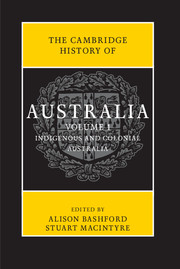Book contents
- Frontmatter
- Contents
- Abbreviations
- List of maps
- List of figures
- List of tables
- Notes on contributors
- Map
- Preface
- Introduction
- PART I
- PART II
- Further reading
- Chronology
- Index
- Frontmatter
- Contents
- Abbreviations
- List of maps
- List of figures
- List of tables
- Notes on contributors
- Map
- Preface
- Introduction
- PART I
- 1 Nation building, 1901–14
- 2 The Great War and its aftermath, 1914–22
- 3 Search for a solution, 1923–39
- 4 World War 2 and post-war reconstruction, 1939–49
- 5 The Menzies era, 1950–66
- 6 Instability, 1966–82
- 7 Growth resumed, 1983–2000
- 8 The new millennium
- PART II
- Further reading
- Chronology
- Index
5 - The Menzies era, 1950–66
from PART I
Published online by Cambridge University Press: 05 November 2013
- Frontmatter
- Contents
- Abbreviations
- List of maps
- List of figures
- List of tables
- Notes on contributors
- Map
- Preface
- Introduction
- PART I
- PART II
- Further reading
- Chronology
- Index
- Frontmatter
- Contents
- Abbreviations
- List of maps
- List of figures
- List of tables
- Notes on contributors
- Map
- Preface
- Introduction
- PART I
- 1 Nation building, 1901–14
- 2 The Great War and its aftermath, 1914–22
- 3 Search for a solution, 1923–39
- 4 World War 2 and post-war reconstruction, 1939–49
- 5 The Menzies era, 1950–66
- 6 Instability, 1966–82
- 7 Growth resumed, 1983–2000
- 8 The new millennium
- PART II
- Further reading
- Chronology
- Index
Summary
The Menzies era began when the Liberal–Country Party Coalition won federal government in December 1949 and Robert Menzies became prime minister for the second time. It ended in January 1966 when the 71-year-old Menzies retired, having won a further six elections. The Coalition won two more elections before being defeated in December 1972 by a rejuvenated Labor Party led by the middle-class lawyer Gough Whitlam. The title of this chapter captures Robert Menzies' dominance of Australian politics during these years. He dominated his party and his governments; his political skills consigned Labor to 23 years of opposition, forcing it to undertake major reforms to rebuild its electability; and for the generation coming of age in the late 1950s and early 1960s, his generally conservative cultural and social outlook seemed to mark the culture. Born in 1894, he was shaped by the values of another age, when Britain ruled the waves and white men were the masters of the world.
Menzies' command of these years was, however, not quite as easeful as it looked from the retrospect of his retirement. The early 1950s were fraught with both economic and political uncertainty as people feared both another world war, this time with nuclear weapons, and an economic recession such as followed World War 1. It was not until the middle of the 1950s that these fears subsided somewhat; and until the Labor split in 1955, elections were close. In 1961 his government hung on by only one seat after it tightened monetary policy. For Menzies' subsequent reputation it would have been better had he lost that election, avoiding acerbic judgements such as those of the social commentator Donald Horne, that by the time he retired he was ‘perplexed by a changing world offering strange problems to which he could not be bothered offering solutions’. Demographically, culturally and economically, Australia had changed a great deal since 1949.
- Type
- Chapter
- Information
- The Cambridge History of Australia , pp. 112 - 134Publisher: Cambridge University PressPrint publication year: 2013
- 2
- Cited by



